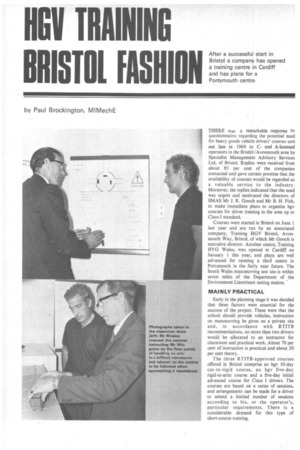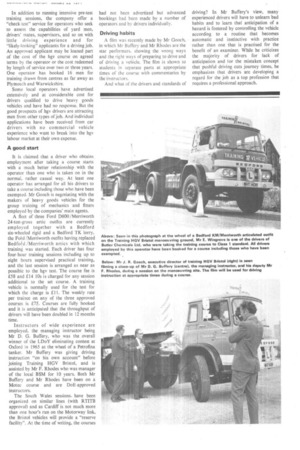HO TRAINING BRISTOL FASHION
Page 44

Page 45

If you've noticed an error in this article please click here to report it so we can fix it.
After a successful start in Bristol a company has opened a training centre in Cardiff and has plans for a Portsmouth centre THERE was a remarkable response to questionnaires regarding the potential need for heavy goods vehicle drivers' courses sent
out late in 1969 to Cand A-licensed operators in the Bristol/Avonmouth area by
Specialist Management Advisory Services Ltd, of Bristol. Replies were received from about 85 per cent of the companies contacted and gave certain promise that the availability of courses would be regarded as a valuable service to the industry. Moreover, the replies indicated that the need was urgent and motivated the directors of SMAS Mr J. R. Gooch and Mr B. H. Fish, to make immediate plans to organize hgv courses for driver training in the area up to Class I standard.
Courses were started in Bristol on June 1 last year and are run by an associated company, Training HGV Bristol, Avonmouth Way, Bristol, of which Mr Gooch is executive director. Another centre, Training HVG Wales, was opened in Cardiff on January 1 this year, and plans are well advanced for opening a third centre in Portsmouth in the fairly near future. The South Wales manoeuvring test site is within seven miles of the Department of the Environment Llantrisant testing station.
MAIN LY PRACTICAL Early in the planning stage it was decided that three factors were essential for the success of the project. These were that the school should provide vehicles, instruction on manoeuvring be given on a private site and, in accordance with RTITB recommendations, no more than two drivers would be allocated to an instructor for classroom and practical work. About 70 per cent of instruction is practical and about 30 per cent theory.
The three RTITB-approved courses offered in Bristol comprise an hgv 10-day car-to-rigid course, an hgv five-day rigid-to-artic course and a five-day initial advanced course for Class I drivers. The courses are based on a series of sessions, and arrangements can be made for a driver to attend a limited number of sessions according to his, or the operator's, particular requirements. There is a considerable demand for this type of short-course training. In addition to running intensive pre-test training sessions, the company offer a "check-test" service for operators who seek to assess the capabilities of yard men, drivers' mates, supervisors, and so on with little driving experience and for "likely-looking" applicants for a driving job. An approved applicant may be loaned part of the cost of the hgv course on agreed terms by the operator or the cost redeemed by length of service over two or three years. One operator has booked 16 men for training drawn from centres as far away as Plymouth and Warwickshire.
Some local operators have advertised extensively and at considerable cost for drivers qualified to drive heavy goods vehicles and have had no response. But the good prospects of hgv drivers are attracting men from other types of job. And individual applications have been received from car drivers with no commercial vehicle experience who want to break into the hgv labour market at their own expense.
A good start
It is claimed that a driver who obtains employment after taking a course starts with a much better relationship with the operator than one who is taken on in the normal, rather casual way. At least one operator has arranged for all his drivers to take a course including those who have been exempted. Mr Gooch is negotiating with the makers of heavy goods vehicles for the group training of mechanics and fitters employed by the companies' main agents.
A fleet of three Ford D800 /Merriworth 24-ton-gross artic outfits are currently employed together with a Bedford six-wheeled rigid and a. Bedford TK lorry, the Ford /Merriworth outfits having replaced Bedfoi'd /Merriworth artics with which training was started. Each driver has four four-hour training sessions including up to eight hours supervised practical training, and the last session is arranged as near as possible to the hgv test. The course fee is £58 and £14 lOs is charged for any session additional to the set course. A training vehicle is normally used for the test for which the charge is £11. The weekly rate per trainee on any of the three approved courses is £75. Courses are fully booked and it is anticipated that the throughput of drivers will have been doubled in 12 months time.
Instructors of wide experience are employed, the managing instructor being Mr D. G. Buffery, who was the overall winner of the I,DoY eliminating contest at Oxford in 1965 at the wheel of a Petrofina tanker. Mr Buffery was giving driving instruction "on his own account" before joining Training HGV Bristol, and is assisted by Mr F. Rhodes who was manager of the local BSM for 10 years. Both Mr Buffery and Mr Rhodes have been on a Motec course and are DoE-approved instructors.
The South Wales sessions, have been organized on similar lines (with RTITB approval) and as Cardiff is not much more than one hour's run on the Motorway link, the Bristol vehicles will provide a "reserve facility". At the time of writing, the courses had not been advertized but advanced bookings had been made by a number of operators and by drivers individually.
Driving habits A film was recently made by Mr Gooch, in which Mr Buffery and Mr Rhodes are the star performers, showing the wrong ways and the right ways of preparing to drive and of driving a vehicle. The film is shown to students in separate parts at appropriate times of the course with commentaries by the instructors.
And what of the drivers and standards of driving? In Mr Buffery's view, many experienced drivers will have to unlearn bad habits and to learn that anticipation of a hazard is fostered by controlling the vehicle according to a routine that becomes automatic and instinctive with practice rather than one that is practised for the benefit of an examiner. While he criticizes the majority of drivers for lack of anticipation and I or the mistaken concept that pushful driving cuts journey times, he emphasizes that drivers are developing a regard for the job as a top profession that requires a professional approach.




































































































